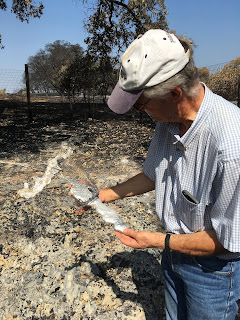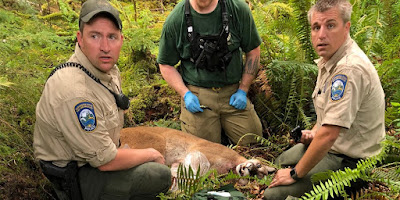Visiting the Mendocino Complex fire - a trip to an old research site.
 |
| Bob Timm holds a piece of melted metal from a shed burned in the River Fire. |
 I spent the years 1986-1991 working at the Hopland Field Station, a University of California research station (and now called the UC Hopland Research and Extension Center). We lived and worked on the station for 4 years, then moved about 8 miles north. The River Fire actually started across the Russian River near Russian River Estates, a stone's throw from where we used to live.
I spent the years 1986-1991 working at the Hopland Field Station, a University of California research station (and now called the UC Hopland Research and Extension Center). We lived and worked on the station for 4 years, then moved about 8 miles north. The River Fire actually started across the Russian River near Russian River Estates, a stone's throw from where we used to live.  |
| Bob Timm points to where the River Fire started. Apparently, the cause was errant sparks from a dangling trailer chain. |
On our way to Mendocino County, we drove through Yosemite National Park. Yosemite Valley was still closed because of fires, but it reopened soon after we passed through.
 |
| The smoke was heavy as we drove through Yosemite. |
At the Hopland Field Station, we wanted to see the 3000 acres that had burned, as well as visit some of the locations we had worked or conducted research. Unfortunately, we didn't have access to all locations. In some places, the road was closed (or 4WD only). We didn't visit a large blue oak stump-sprout research plot I established around 1990, which may be valuable because some of the plots were fenced off from sheep and deer. I believe our fenceposts were wood, however, and we observed many sections of fencing with wooden posts burned and down. That doesn't bode well for the fence still being intact!
 |
| The River Fire burned through the field station and into the BLM's Cow Mountain Recreation Management Area. |
 |
| Observation shed |
Bob Timm and Guy Connolly conducted coyote behavior research at Hopland (this work had begin in 1972 with Bill Longhurst and Howdy Howard), and I later maintained the facility as a graduate student, measuring coyote responses to chemical scents (we found sex-specific scents, and scents that elicited particular behaviors, like rub-roll or lick-chew). When we visited the coyote pens (there had been no coyotes for years), the complex was burned to the ground. The storage sheds and observation sheds were gone, and all that remained of the wooden gates to the facility were the metal hinges.
 |
| This photograph, taken by Guy Connolly at the Hopland coyote pens, has been distributed widely. |
 |
| Bob Timm and I "sheepishly" restaged the photo above, in the remnants of the Hopland coyote pens. |
 |
| The remnants of the coyote pens. |
A week following the fire, many of the blue and valley oaks were losing their leaves. The brown leaves falling everywhere were eerily reminiscent of leaves in autumn, but in this case the leaves were either scorched by the heat or falling from dead trees. I was surprised at the level of tree damage, because the understory in many areas was range grasses, and I wouldn't have thought that there was enough heat from a grass fire to kill these trees. However, a number of large branches and even whole trees had fallen to the ground, and in some cases you could see the remaining white ash of an entire tree that had fallen to the ground and was consumed by fire.
 |
| At this location, a large blue oak fell and was burned. You can see where the large branches plowed into the ground, and all that is left is the ash. |
 |
| These sheep are in a lower pasture than didn't burn. Note the limited vegetation on the ground. However, the grazed areas had enough vegetation to maintain the blaze and ignite trees and fenceposts. |
This would be a good time to follow animal tracks, as they were very obvious in the black ash. I expected to see a least a few dead animals (vultures bring them to your attention), but we observed none. Bob had heard that more black-tailed deer fawns were being observed than expected. I doubt that adults would be more susceptible to fire than fawns so, if this is true, I suspect fawns were separated from their mothers during their escape from the flames. I did notice some huge acorn woodpecker granary trees on the ground. The loss of these trees may have local population impacts on these woodpeckers. Adults store thousands of acorns in these trees. It's a food resource used by the adults during nesting. The adults feed insects to the young, and feed themselves on the acorns during this time. If there are no acorns, then the adults eat the insects, at the expense of the young.
 |
| You can see the "autumn" look of the burned site, with the dead or scorched leaves on the ground and the brown canopies. |
 |
| Woody branches completely consumed in the flames. |
 |
| Even though the fire was 100% contained, some places were still burning. Here, you could feel the heat from embers within the wood. |
As we drove west through Sacramento on our way home, the smoke from the fires gave the rising sun an apocalyptic feel.











Comments
Post a Comment